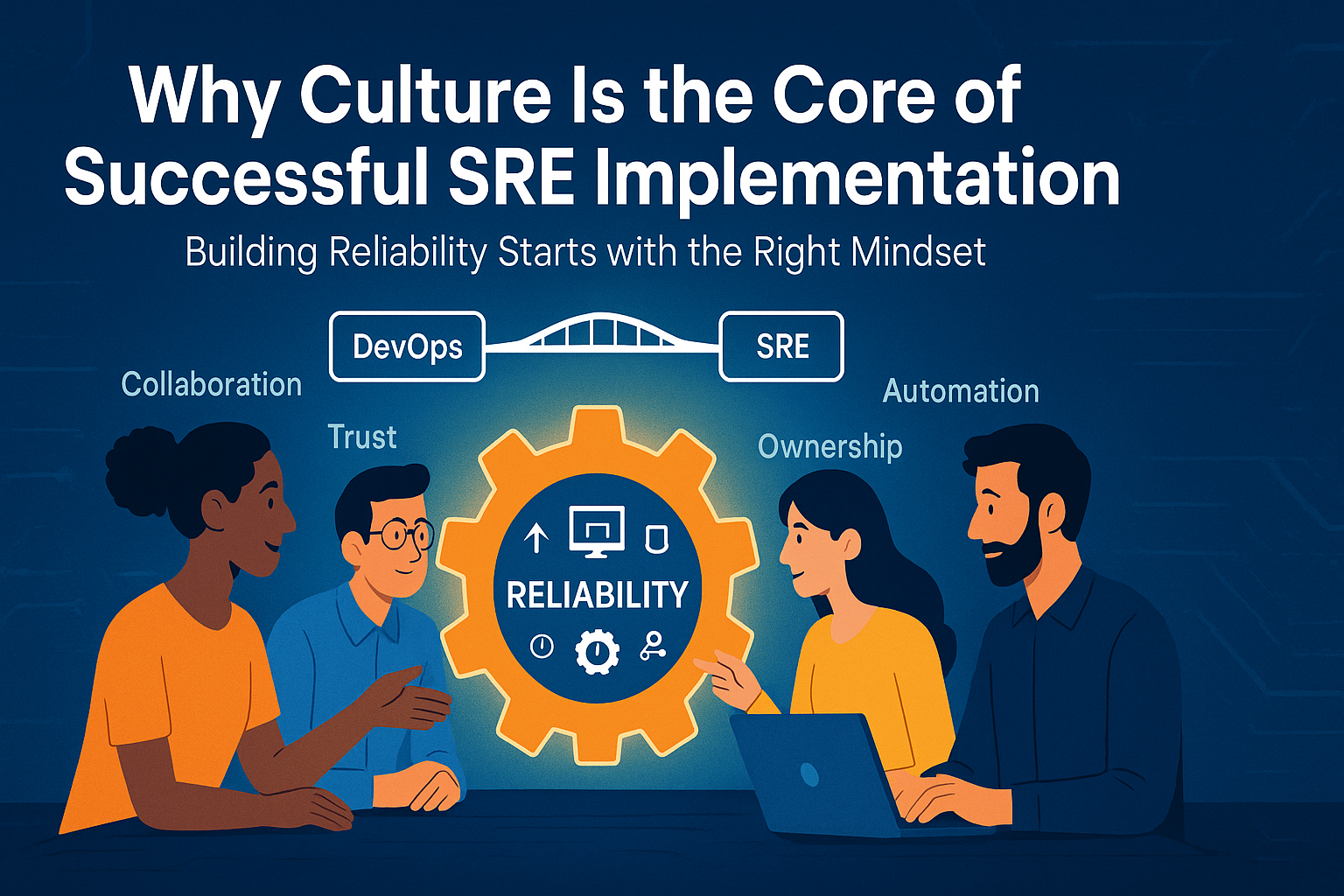In today’s digital world, organizations depend on their systems to run seamlessly, deliver exceptional user experiences, and scale effortlessly. Site Reliability Engineering (SRE) has emerged as the bridge between development and operations, ensuring reliability without compromising innovation. However, tools and automation alone don’t make SRE successful — culture does. The culture behind SRE defines how teams think, collaborate, and act to achieve reliability goals.
Learn More: SRE Culture: How It Relates and Connects with DevOps

The Human Side of SRE: More Than Just a Process
At its heart, SRE is about people, not just processes. While the concept was pioneered by Google, the success of any SRE implementation depends on how well teams embrace its mindset. SRE culture revolves around shared ownership, accountability, transparency, and learning from failure.
Unlike traditional IT operations, where development and operations function in silos, SRE culture fosters collaboration. Development teams write code with reliability in mind, while operations teams gain visibility into application performance from the start. This shared understanding builds trust and breaks down barriers — the foundation of high-performing reliability teams.
Core Cultural Values Behind SRE Success
1. Embracing Failure as a Learning Opportunity
In a reliability-driven environment, failures are inevitable. Instead of assigning blame, SRE culture promotes a blameless postmortem approach. This encourages teams to analyze what went wrong, identify systemic issues, and prevent similar failures in the future — without fear or judgment.
2. Shared Responsibility and Ownership
Traditional DevOps teams often operate separately, but SRE encourages shared ownership of reliability goals. Both developers and reliability engineers collaborate to maintain Service Level Objectives (SLOs) and Error Budgets — measurable metrics that define the acceptable level of risk. This cultural alignment ensures everyone contributes to reliability outcomes.
3. Balancing Innovation and Stability
SRE culture strikes a balance between velocity and reliability. Teams are empowered to deploy new features rapidly while keeping systems stable. Error budgets act as a control mechanism, allowing innovation without sacrificing performance.
4. Continuous Improvement Through Data
SRE thrives on data-driven decision-making. Metrics like SLIs (Service Level Indicators) provide actionable insights into system health. By embedding these practices into the culture, organizations continuously improve their reliability posture.
Why Culture Determines SRE Implementation Success
Implementing SRE is not just about introducing new tools or processes — it’s about changing how teams think. When organizations skip the cultural transformation and only adopt the technical aspects, SRE initiatives often fail.
A successful SRE culture encourages:
Open communication between teams
Respect for measurable reliability goals
Acceptance of controlled failure
A mindset of constant learning and iteration
Companies that invest in SRE culture experience smoother deployments, faster incident resolution, and higher customer satisfaction. The result is a resilient digital ecosystem that adapts quickly to changing user demands.
Building a Reliability Career: Importance of SRE Foundation and Practitioner Certifications
As the demand for reliability engineers grows, professionals need to understand both the mindset and the methods of SRE. That’s where SRE Foundation and SRE Practitioner certifications become essential for career growth.
SRE Foundation Certification
SRE Foundation Certification helps you grasp the fundamentals — from SLIs and SLOs to automation, incident management, and cultural transformation. It’s ideal for those transitioning from DevOps, IT, or software engineering roles who want to learn how to build a reliability-first mindset.
SRE Practitioner Certification
Once the fundamentals are clear, the SRE Practitioner Certification level dives deeper into real-world implementation. It covers advanced practices like scaling reliability, automating operational tasks, and aligning cultural values with business objectives.
By earning this certification, you demonstrate your ability to lead reliability initiatives, influence organizational culture, and drive continuous improvement.
Together, these certifications not only strengthen your technical knowledge but also prove your commitment to fostering an SRE-driven culture — a key differentiator in today’s competitive IT landscape.
Conclusion
Culture is the invisible force that makes or breaks SRE implementation. When teams adopt a culture of trust, collaboration, and learning, they transform reliability from a goal into a shared responsibility. And by upskilling through certifications like SRE Foundation and SRE Practitioner, professionals can play a vital role in shaping that culture — ensuring their organizations achieve both reliability and innovation at scale.
 Never miss a story from us, get weekly updates in your inbox.
Never miss a story from us, get weekly updates in your inbox.